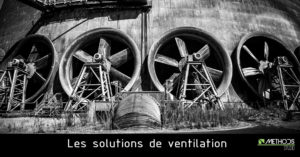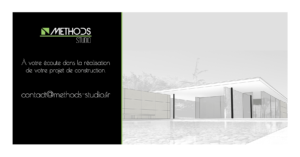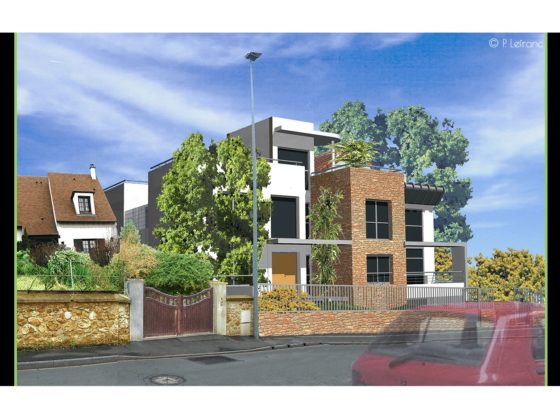 VMC controlled mechanical systems, EAS safe waiting areas, Floor Ventilation, Single Flux, Double Flux – there are so many, sometimes complex, terms to understand when it comes to installing efficient ventilation in a house, apartment or establishment open to the public. To enable you to pick the right ventilation, here is Methods Studio Architects’ run down of all the solutions existing on the market. Happy reading!
VMC controlled mechanical systems, EAS safe waiting areas, Floor Ventilation, Single Flux, Double Flux – there are so many, sometimes complex, terms to understand when it comes to installing efficient ventilation in a house, apartment or establishment open to the public. To enable you to pick the right ventilation, here is Methods Studio Architects’ run down of all the solutions existing on the market. Happy reading!
Why ventilate your house or apartment? The solutions
Why is ventilation important?
There are three benefits to be gained from ventilating an apartment or a house: health, the longevity of the home, and safety.
For the good of your health, it is important to ventilate your house or apartment to maintain good indoor air quality. We produce a high amount of pollutants as we go about our daily lives. Our air is polluted by our breathing, cooking, tobacco, household cleaning products, furniture varnishes, and heating appliances (wood-burning stoves and gas boilers etc.). It is important to remove these pollutants from indoors, as they can lead to long term health problems.
For the longevity of a building, an efficient ventilation solution reduces humidity inside the house, and thus the risk of mold. Some materials, such as plaster and wallpaper for example, are unable to withstand high levels of humidity. Keeping indoor air healthy will allow you to better maintain your home or apartment, and thus limit costs in the long term.
Finally, good ventilation improves the safety of your home, particularly if you have a combustion heating system (wood or gas). A gas boiler or a wood-burning stove can release carbon monoxide during combustion. Without effective ventilation, carbon monoxide is an extremely dangerous gas since you can’t smell it but it is lethal above a certain concentration in the ambient air.
When should you ventilate?
All the time! Efficient ventilation must be in operation at all times. Indeed, since 1969, French law requires that all new dwellings, houses and apartments be equipped with a central and permanent ventilation system. You will therefore need to install a ventilation solution in your home.
During cold periods in winter, we tend to want to draft-proof our home to prevent our heating bills going through the roof. However, you still need to keep your ventilation system running so it can fulfill its health and safety role.
If you want advice and support in building or renovating a house, trust our team: https://www.methods-Studio.fr
Ventilation solutions in Paris
How to ventilate?
The ventilation of an individual home, and more generally of a building, can be done in two ways: either by natural draft or by mechanical draft. In the case of mechanical ventilation, we use the term VMC (or CMV).
In general, ventilation solutions for individual homes are based on controlling the flow of air coming into and leaving the home. The air enters the house through air inlets located in the “dry” living rooms, (lounge, bedroom, etc.) generally above the windows, and is expelled through the “wet” utility rooms (kitchen, bathroom, or laundry room), where the air is warmer and more humid.
Finally, remember to ventilate your basements, cellars and crawl spaces, which, very often being below ground level, do not benefit from the effects of natural ventilation. You may well need to install a special ventilation system in these areas to maintain good quality ambient air, thus reducing the likelihood of mold or humidity and ensuring materials last longer.

Can you ventilate your home simply by opening the windows?
Opening windows to ventilate is useful for renewing the ambient air, but is not considered an approved ventilation solution. Indeed, this is not a continuous ventilation solution, and it does not have a direct effect on the source of the contaminants (your boiler etc.).
Ventilation systems offered by Methods Studio Architects partners
Several ventilation systems are available today on the French market; here is a non-exhaustive list of what you may encounter.
VMC, Controlled Mechanical Ventilation
VMC or CMV is the most common ventilation solution for a house or apartment. There are two types of CMV: single flow CMV, and dual flow CMV. The general principle of single flow CMV is as follows. Small openings are placed above each window of the dry rooms and are calibrated to let a stream of air pass. Openings and ducts are placed in the wet rooms (bathroom, kitchen, and laundry room, etc.). These suck the ambient air into an extractor (fan) usually placed on the roof.
Dual flow CMV works slightly differently. The outside air enters through a duct generally located on the roof, and passes through an air-air exchanger which balances the temperature with the air expelled to the outside. The incoming air is then distributed in the dry rooms of the house or apartment, and sucked into the wet rooms (bathroom, kitchen, etc.), as with single flow CMV.
Basement Ventilation
For a semi-underground or non-underground basement or cellar, you can use the same CMV systems as in the rest of the house. You can install air inlets above the doors or windows of your basement or cellar.
In the case of an underground cellar or basement, that is to say without a direct opening to the outside, or for your crawl space, you could try installing a window onto the areaway. In addition to ventilating the basement or cellar, you will bring natural light to your underground space.
 Alternative solutions to CMV
Alternative solutions to CMV
It is not always possible to install CMV when renovating an old building or house. For CMV, you have to install vertical ducts, and this may not be feasible.
In this case, you could opt to install VMR or DMV (Distributed Mechanical Ventilation). DMV works on the same basic principle as the CMV: air inlets through the dry rooms, extraction through the wet rooms (bathroom, kitchen, etc.). While the air is sucked into a single extractor, usually under the roof, for CMV, in the case of DMR each service room has its own small fan to locally extract the air to the outside, generally via a horizontal duct that is easier to make than a vertical duct.
This video will show you the various CMVs on the market: https://www.youtube.com/watch?v=MrTI6ldDcpk
EAS ventilation (Safe Waiting Areas)
Finally, regarding establishments open to the public, designing a safe waiting area is mandatory. An SWA is a zone free from smoke, flames and thermal radiation for people with disabilities. The only circumstances under which an SWA is not required are: if the building consists of a ground floor with accessible exits, practicable on one level for people with reduced mobility; if the building has several floors and practicable exits leading directly to the outside at each level, and allowing people to move far enough away so as not to be injured; if appropriate measures have been approved by the safety committee (request for exemption).
In addition to being legally compulsory, ventilating a private home is necessary to maintain good ambient air quality in a house or apartment, and more generally in a building. It is an important factor for your health and safety and will make your house or apartment last longer. If in doubt about what solution best suits your construction or renovation project, get help from a professional. Thanks to their expertise you will find the right solution within your budget!
 The Methods Studio Architectors team
The Methods Studio Architectors team
Only when you are satisfied is our job done
follow us on LinkedIn
Contact our architect-builders: contact@methods-Studio.fr






